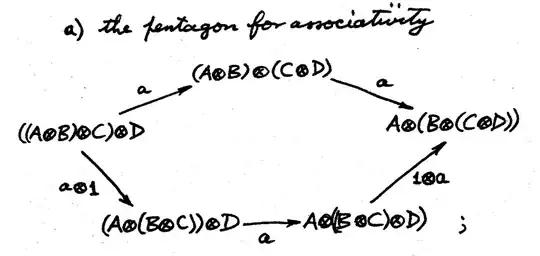The following construction is not really presenting tensor product "as an initial object somewhere", but rather showing that one can encode $R$-balanced maps into diagrams of group homomorphisms, hence one can indeed think of the tensor product as a colimit (of Abelian groups).
I assume the question is concerning the tensor product of modules (for which the tensor product o f vector spaces is a special case), i.e. $M \otimes_R N$ when $M \in \mathrm{Mod}-R, \; N \in R-\mathrm{Mod}$.
Consider the following diagram in $\mathbf{Ab}$:
Its objects are:
1) For every $n \in N,$ an Abelian group $M_n \simeq M$,
2) for every $n_1,n_2 \in N$, the direct sum $M_{n_1} \oplus M_{n_2}$.
Its arrows are given as follows:
1) For every $r \in R$ and every $n \in N$, a map $M_{rn}\rightarrow M_{n}$ defined as $m \mapsto mr$ (which is a group homomorphism, obviously),
2) For every $n_1, n_2 \in N$, there are inclusions $M_{n_1}\stackrel{i_1}\rightarrow M_{n_1}\oplus M_{n_2}$, $M_{n_2}\stackrel{i_2}\rightarrow M_{n_1}\oplus M_{n_2}$ and a diagonal map $\Delta: M_{n_1+n_2} \rightarrow M_{n_1}\oplus M_{n_2}$ (i.e. given as $m \mapsto (m,m)$).
Now, observe that whenever one has a collection of group homomorphisms compatible with the diagram, i.e. a collection of group hom's $f_n:M_n \rightarrow A$ such that the first property of colimit is satisfied, one has that
$$\forall m \in M \; \forall n \in N \; \forall r \in R: f_{n}(mr)=f_{rn}(m)$$
(which follows from compatibility with the arrows from 1) ), and also
$$\forall m \in M \;\forall n_1, n_2 \in N: f_{n_1+n_2}(m)=f_{n_1}(m)+f_{n_2}(m)$$
(which follows from the part 2) ). The last condition, i.e.
$$\forall m_1, m_2 \in M \;\forall n \in N: f_{n}(m_1+m_2)=f_{n}(m_1)+f_n(m_2)$$
is satisfied trivially since all the $f_n$'s are group homomorphisms.
In other words, one can associate to such the $R$-balanced map
$f:M\times N \rightarrow A$ defined as $$f(m,n):=f_{n}(m).$$
On the other hand, it is also clear that whenever one has an $R$-balanced map $g:M\times N \rightarrow A$, one can construct a collection of group homomorphism compatible with the diagram by setting $g_n:M_n\rightarrow A$ to be $g(-,n)$.
Thus, being universal among $R$-balanced maps is morally the same thing as being universal among the co-cones (i.e. "compatible collections of morphisms") of the diagram described above. Thus, $M\otimes_RN$ is (naturally isomorphic to) the colimit of the diagram.
Also note that the choice of $\mathbf{Ab}$ is not some compromise, but a necessity, since in general $M\otimes_R N$ is just an Abelian group, i.e. not necessarily a left or right $R$-module. If the ring $R$ is commutative (as in the case of fields), one can adjust the construction to obtain the tensor product as a colimit in $R-\mathrm{Mod}$.

